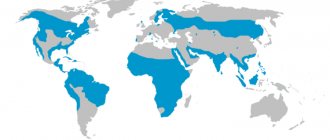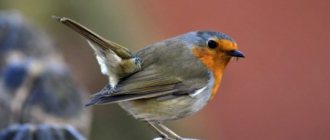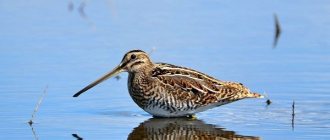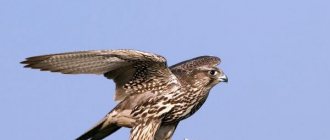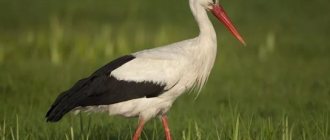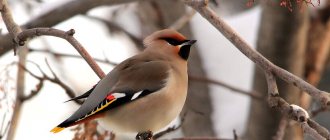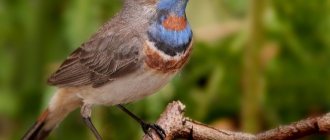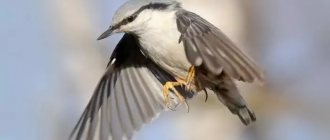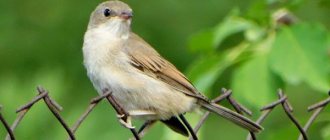Robin - bird: photo, description
A small bird similar to a sparrow, but with bright colors! Robin is a bird with rich red plumage in the abdomen and chest area. The robin's wings are light gray with a greenish tint and thin white stripes. On the throat, upper part of the breast and on the sides, the bird's plumage has a rich red color. If you look at a photo of a robin bird, you will notice that this representative of birds is distinguished by a thin, pointed beak and long legs. The bird's paws seem fragile, but in reality they are very tenacious. Along with a long tail, made of elastic, hard feathers, the robin’s paws serve to nimblely climb tree trunks and branches.
Robin on a tree
Character and lifestyle of the robin
The robin is a migratory bird , which by its nature is a strict and consistent individualist. She prefers not only a solitary lifestyle, but also solo flights.
These birds have a very well developed possessive instinct, and they can attack their neighbors who dare to be on their territory. Birds are active mainly during daylight hours, however, they can also be seen on a moonlit night or in the most illuminated places in the rays of night sources.
hear the robin bird in the evening or at night. During the mating season, males sing, attracting females with their own vocal talents. Robins prefer to build nests directly on the ground or near its surface.
They especially love places such as holes, rotten stumps, crevices between tree roots, or even abandoned burrows left by various mammals. To build the outer walls of the nest, the robin bird uses moss, as well as dry leaves and branches.
The interior of the nest is usually covered with feathers, wool, hairs, straws and thin roots. The robin always builds a reliable protection from rain over its own home or inhabits a recess into which moisture does not penetrate.
Male and female robin birds, what is the difference?
The bird with an orange breast and gray back loves to be alone! This is one of the characteristics that robins are endowed with. The male and female prefer to be apart. Therefore, learning to distinguish them is quite difficult.
You can distinguish a male from a female by the manner of mating behavior in those rare moments when the birds are in the mating season and are nearby. During the nesting season, the female robin builds a nest and incubates the eggs. The male occasionally pampers his female with attention in the form of help in finding food.
There are differences in color. The bird with a red breast and a scarlet belly with an orange tint is most likely a female. Males have a characteristic rich red-purple belly color. The male robin also has a small white spot above its beak.
Robin with raspberries
Feather color as information
Why are birds so bright? For whom did the robin color its breast so brightly? After all, this is how she unmasks the seed. Any predator, even with poor eyesight, will see a red speck jumping in the bushes. And here not only males, but also females have a bright spot.
In birds, vision is the main sense organ from which they receive information. Of all the many visual signals, birds, first of all, need to recognize the enemy, food, chicks and individuals of their own species, especially if it is a representative of the opposite sex.
Each individual has identification marks by which it can be classified as “one of our own”. This is extremely important for any kind of communication. A bright spot on a robin serves as an identification mark of belonging to:
- to this species;
- a certain gender;
- stage of puberty.
Differences in the brightness and configuration of the crimson spots provide the individual with information that there is a rival or reproductive partner in front of it. Since these birds are insectivores, their coloring cannot serve as a recognition of potential prey. But red-breasted birds for the chicks are a sign that their own bird has flown to them, which can feed them. It is at this moment that you need to scream and open your beak wide. If something flies up without a bright spot, then you need to freeze silently, merging with the nest.
Thus, the bright coloring of a small bird carries some risk of unmasking, but it allows you to quickly obtain the necessary information, recognizing your partner in the hard work of feeding the successors of its kind.
Where does the robin bird live?
The habitat of these birds, similar to sparrows, but with brighter, richer colors, is incredibly wide! Birds of this species live throughout Europe. They can be found in the Mediterranean, Siberia, in the mountainous regions of the Caucasus, Caspian Sea, and Black Sea coast. The small bird Robin lives in Uzbekistan, Georgia, Armenia, Tatarstan.
Representatives of this species can be found throughout Belarus and Ukraine. The bird's habitat extends to the Australian coast, the USA, Spain, and Mexico.
The main habitat preferred by the orange-breasted bird is mixed forests. The robin loves to settle near rivers and other bodies of water. The bird is close to a humid, warm tropical climate, so it prefers to spend the winter in countries with characteristic weather conditions in winter.
Photo of a robin bird
Habitats and feeding preferences
This bird prefers to live in the forest. However, she does not like the dense taiga, but mixed forests with dense undergrowth, clearings, edges and forest windows. The robin especially loves thickets near bodies of water - in floodplains, on the shores of lakes.
The robin can live next to a person if he does not interfere with it and creates thickets with trees of different heights, bushes and grass. True, humans are accompanied by cats, which turn into the main enemies of these birds.
Despite the fact that the robin is considered an insectivorous bird, in spring and autumn, when animal food is in short supply, it feeds on seeds and berries. At the height of summer, when the chicks are squeaking in the nest, the red-breasted father and mother tirelessly hunt for caterpillars, spiders, worms and other protein foods.
In nature, the main enemies of robins, apart from humans and cats, are representatives of the mustelidae family (sable, weasel, mink, marten, ferret). Badgers, foxes, wolves and, of course, domestic dogs love to destroy robins' nests. From the bird world, all small birds of prey are interested in adult robins and their chicks, including shrikes, which steal chicks from nests, eat them or store them, attaching them to twigs or thorns.
The entire life of a robin, like every earthly creature, is devoted to performing 2 functions: to be someone’s food supply and to limit the number of someone who is its food supply. However, she has one more function - to delight a person with her voice and bright outfit.
Robin bird: photos and descriptions of species
Ornithologists distinguish several varieties of the bird in question. What does a robin look like depending on the species difference?
January Robin
A bird similar to a sparrow lives on the island of Java, Asia Minor, Indonesia. A different color of the robin is typical for that area. If we usually think that a robin is a bird with an orange breast, this one is a bright blue colorful bird.
Mountain White-tailed Robin
In Siberia and the Caucasus you can find birds that look like sparrows of a deep blue color with bright white stripes on the tail. This is a white-tailed mountain species that is not inferior to its relatives either in singing abilities, or in size, or in lifestyle.
Photo of Mountain White-tailed Robin
Black-throated Robin or Ryukyu Nightingale
In Japan, Taiwan, on the Ryukkyu Island and on the shores of the South China Sea, they know a special variety of this bird with characteristic black plumage in the neck, chest and head. This robin is a bird with incredible singing abilities. She is known and appreciated for the “nightingale” trills that are heard in her habitats during the warm season.
robin bird
The photo of the subspecies shows that this bird has a classic orange-red belly color, gray wings and tail. The largest population, the common robin, has a sonorous singing voice, small size, and friendly character.
Photo of a robin
Small birds that look like a song robin
The robin vaguely resembles a chaffinch. This is also a bird with an orange tail, similar to a sparrow. Similar indicators of size, body weight, and wide wingspan bring this bird closer in description to a robin. However, the finch is a member of another family (finches). He has different eating habits and characteristic differences in his lifestyle.
The small redstart can be unknowingly confused with a robin. The photo shows that these are red birds with gray plumage on the back, tail and wings, the size of a sparrow. The redstart has a similar lifestyle and habitat to the robin. These are representatives of the same family.
Bullfinch - the bird in the photo vaguely resembles the Robin in question. However, similarities can be seen in body structure and size. The habitat of bullfinches also shares similarities with the robin. But these birds have their own characteristics in their way of life, they have different feeding habits and are not distinguished by the same outstanding singing qualities as the robin, whose voice is sung by poets.
Photo of a finch
Reproduction and lifespan of a robin
Reproduction in these birds occurs twice a year, and in one clutch the female brings from five to seven eggs, from which young offspring are born two weeks later.
The photo shows a robin's nest
“Newborn” chicks do not have feathers, but after about half a month they already begin to leave the nest. In the first days of life, the chicks are very voracious and destroy many larvae and caterpillars of harmful insects, thereby providing an invaluable service to orchards and groves.
Despite the rapid deforestation of the forests in which the robins lived, the birds managed to change their location and perfectly adapt to the new conditions. Therefore, the fact of destruction of forests did not negatively affect the population of these birds.
Mortality among juveniles is quite high, since the chicks are very trusting and most of them do not live to be one year old. If a robin can survive its difficult first year of life, then it is highly likely that it will live up to twelve years.
Description of the migration characteristics of the Robin bird
The bird with an orange breast, whose name is robin, arrives very early - at the end of March and beginning of April. This bird flies away for the winter towards the end of October. Some individuals go to warmer climes only towards the end of November. And other representatives of this species of birds even remain to spend the winter in climatic regions with average low temperatures. During the wintering period, they settle near heating mains, near non-freezing springs, and in non-snowy areas of the area.
Photo of a robin bird
What bird nests look like: photo and description
Robin eggs can be found in nests located on the lower tiers of tree trunks, in cracks and niches with narrow spaces. The nests themselves are untidy, made of thin twigs and natural material. The robin's eggs should be safe. That is why the bird is looking for an obstacle in the form of a stone or a natural curtain to organize a nest. The base of the nesting site must be covered. At least that's what the robin thinks. A photo of the bird during the nesting period shows that the females have a very developed “maternal” instinct. In a year, a bird can give birth to two generations of offspring.
Drawing of a robin with chicks
Zoryanka (or robin) at home
This bird quickly adapts to captivity. She is incredibly friendly and easy to care for. However, to keep a robin at home, it is important to provide it with adequate nutrition. Food for the robin consists of living creatures: bugs, larvae, worms, dragonflies. This bird can also eat cereals and berries.
A bird singing at dawn will delight you with its clear voice for quite a long time! The average life expectancy of a robin in captivity is 7-8 years (up to 12 years maximum). But in its natural environment, the bird lives for a maximum of 2 years.
Robin in arms
Interesting Facts
Where does the bird's name come from?
Many people wonder why the bird was named Robin? But it’s not hard to guess! The robin is a bird whose singing can be heard at dawn. But her loud chirping can be heard in the evenings.
What is the correct name?
Robin or zoryanka - the spelling of the name of the bird has the same root origin as the word “dawn”. However, among the common people this period of the day is affectionately called “dawn”. Surely, both options occur, if not in literary writing, then certainly in the conversational genre.
Robin feeding
The robin's diet consists mainly of centipedes, spiders, beetles, worms and all kinds of mollusks. The search for food of these birds is concentrated mainly along the surface of the earth.
Robins are also not averse to eating all kinds of berries and seeds, which people often feed them in city parks and squares. Most of all, the robin loves berries such as blackberries, currants, elderberries and rowan.
